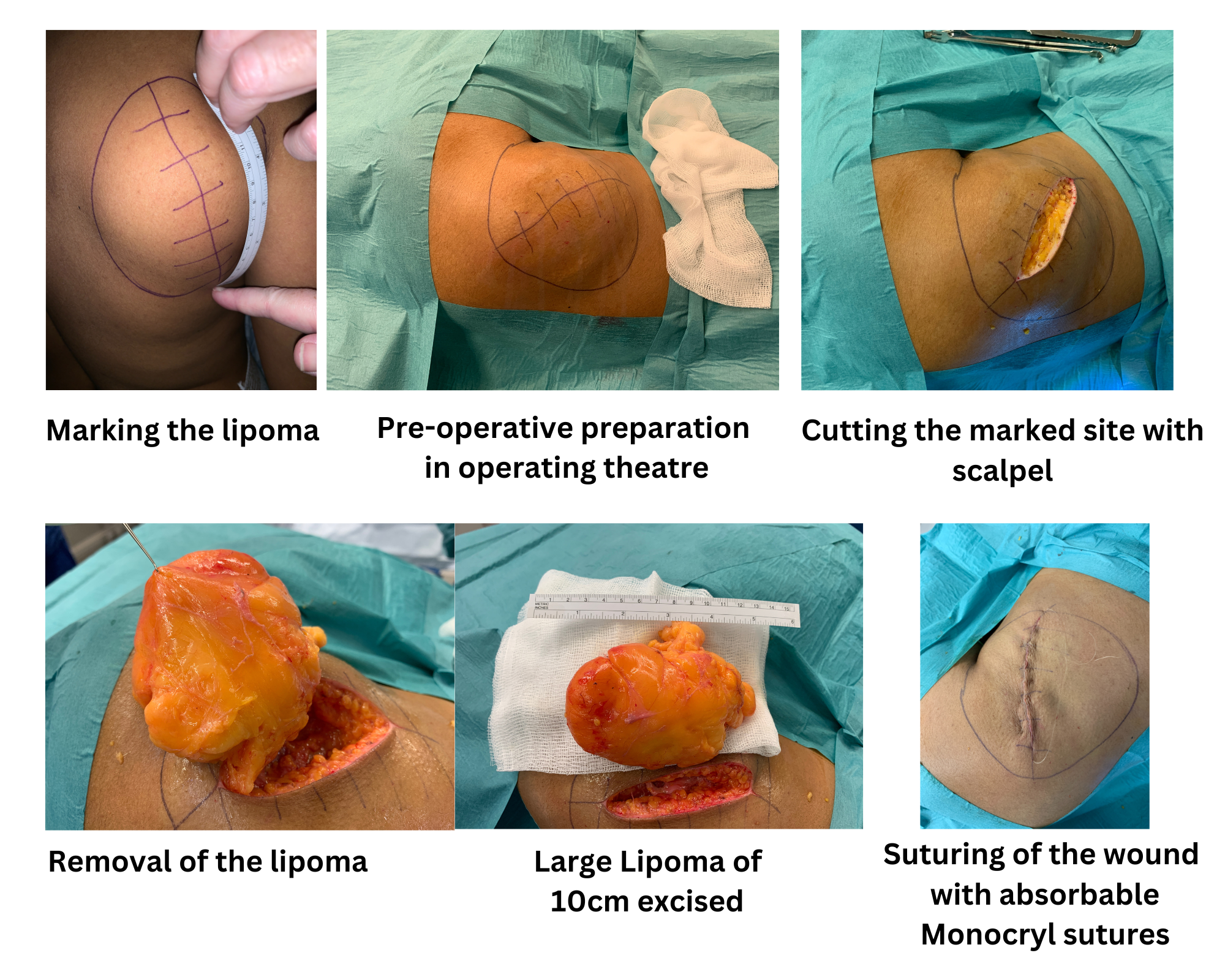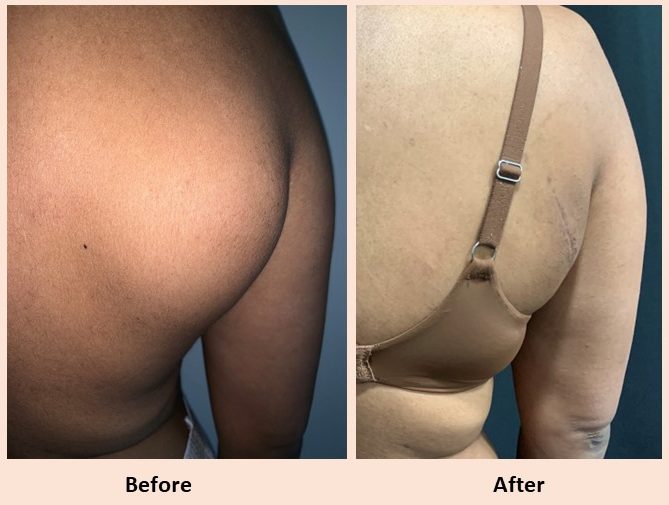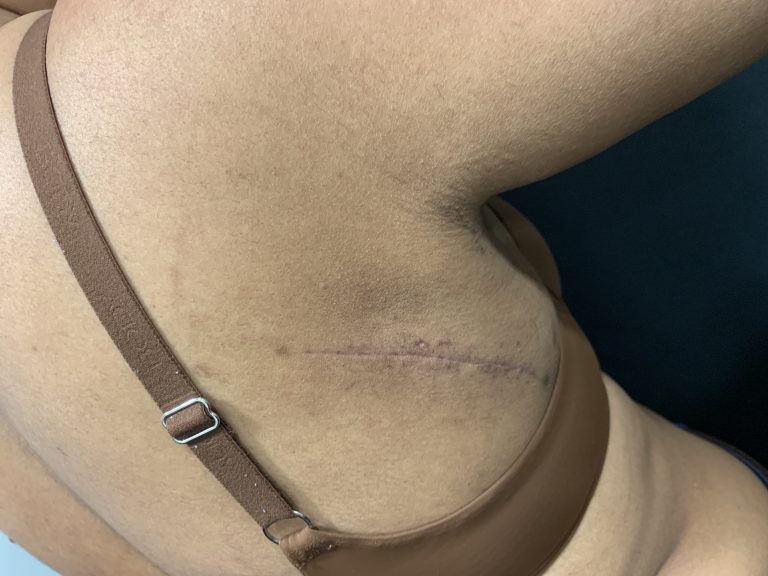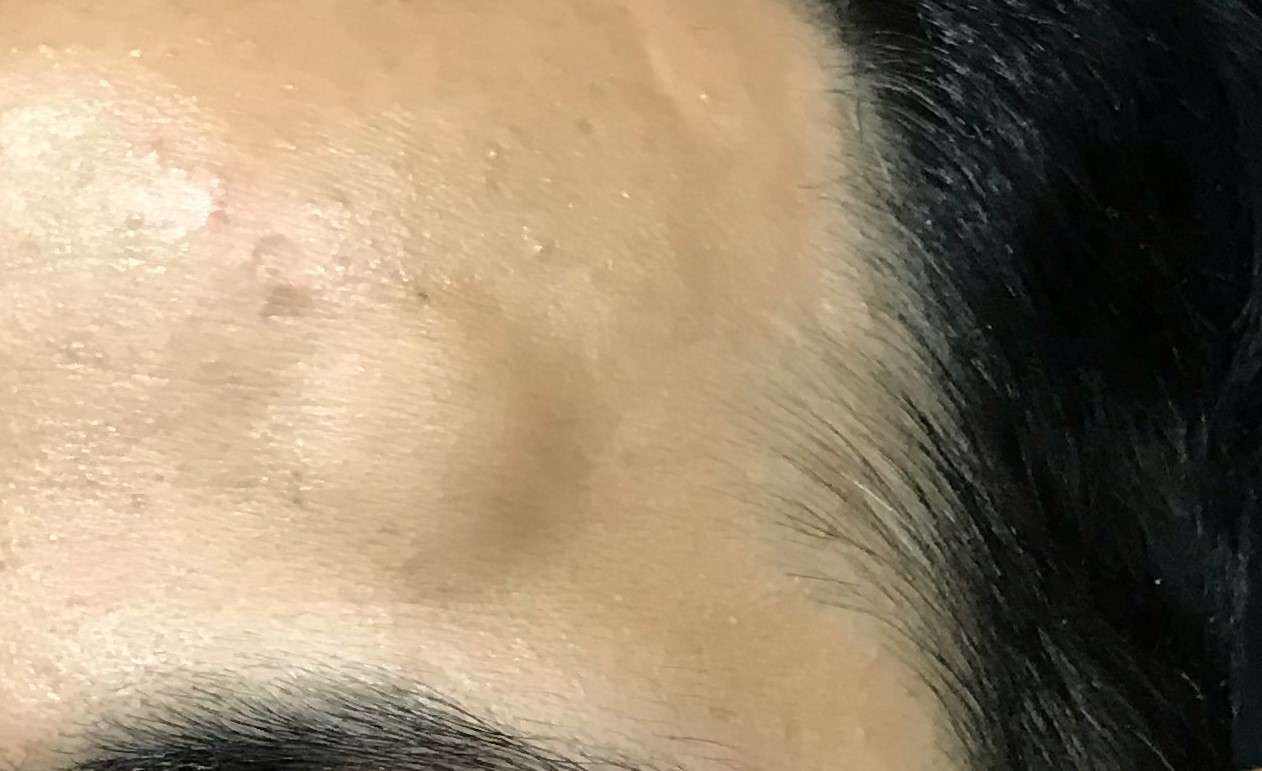Soft tissue swellings can arise from a wide range of tissues, including muscles, fat, nerves, blood vessels, and connective tissues. Each type of swelling has its own unique characteristics, causes, and treatment approaches. Here are the different types of soft tissue swellings commonly encountered:
- Lipoma
A benign tumor of fat cells, typically soft, painless, and mobile. Commonly occurs on the torso, neck, upper arms, and thighs.
2. Cyst
Includes epidermoid cysts (from hair follicles), sebaceous cysts, and ganglion cysts (arising near joints or tendons). Cysts are fluid-filled sacs and may feel smooth and round. They are often painless but can become infected, causing pain and redness.
- Hematoma
A collection of blood outside blood vessels, typically due to trauma or injury. Swelling with a bluish discoloration and tenderness.
- Abscess
A localized collection of pus caused by infection. They are painful, swollen, red, and warm to the touch. May cause fever or other systemic signs of infection.
- Ganglion Cyst
A fluid-filled sac that commonly forms near joints or tendons, particularly around the wrist. They are firm, round, and often painless, but can cause discomfort or limit joint movement.
- Dermatofibroma
A small, benign growth of fibrous tissue in the skin, usually following trauma or insect bites.
These are firm, raised, and often darker than surrounding skin.
While the causes of soft tissue swellings are diverse, lipomas are among the most frequently encountered benign tumors.
What is a Lipoma?
A lipoma is a benign tumor composed of mature adipocytes (fat cells) and is typically slow growing. These tumors are usually soft, mobile, and painless. Lipomas can occur anywhere on the body where fat cells are present but are most commonly found on the torso, neck, upper thighs, forearms, and armpits. Although generally harmless, lipomas can sometimes grow large or develop in areas that cause discomfort or other symptoms.
How to identify a Lipoma?
Lipomas are generally easy to identify based on their clinical characteristics:
- Texture: Soft and doughy to the touch.
- Mobility: Easily movable under the skin.
- Size: Typically small, ranging from 1 to 3 centimetres in diameter, though they can grow larger.
- Pain: Usually painless, though some lipomas may cause discomfort if they press against nerves or contain a significant number of blood vessels.
While most lipomas are asymptomatic, some patients may experience pain, particularly if the lipoma compresses nearby nerves or if it is situated in an area of frequent pressure or movement.

How to diagnose a Lipoma?
The diagnosis of a lipoma is primarily clinical, based on the history and physical examination. However, in some cases, imaging studies such as ultrasound or MRI may be necessary to differentiate a lipoma from other soft tissue masses, particularly if the lipoma is unusually large, firm, or deeply situated. In rare cases, a biopsy may be required to confirm the diagnosis and rule out liposarcoma, a malignant tumor of fatty tissue.
Management of Lipoma at MACS Clinic
1. Steps for Booking a Consultation with Mr. Shailesh Vadodaria at MACS Clinic
You can reach out to our clinic using any of the following methods:
- Phone: Call the clinic directly at 020 7078 4378.
- WhatsApp: Send a message to 07792 648 726
- Email: Contact the clinic at enquiries@macsclinic.co.uk.
- Online Contact Form: Visit the clinic’s website and fill out the contact form with your details – macsclinic.co.uk/contact-us
When contacting the clinic, ensure you include your complete name, preferred method of contact(email/phone/WhatsApp) and mention the specific procedure you are interested in, such as Lipoma excision.
2. Scheduling Your Consultation
After receiving your inquiry, a member of the MACS Clinic staff will reach out to you to schedule your consultation. You will be offered the option of a complimentary/free video consultation or an in-person consultation at the clinic, depending on your preference.
Before your consultation, our clinic team will provide you with a detailed information factsheet about the procedure you are interested in, such as Lipoma excision. This document will give you an overview of the procedure, helping you to understand what to expect during and after the surgery.
During your consultation with Mr. Shailesh Vadodaria, our senior consultant plastic surgeon, he will explain all aspects of the Lipoma excision procedure, including the surgical process, potential risks, complications, and expected outcomes. Detailed post-operative care instructions will be discussed to ensure a smooth recovery.
Mr. Vadodaria will also share representative before-and-after photos or videos of previous patients who have undergone Lipoma excision, helping you visualize the potential results.
3. Cost of the Lipoma excision procedure
Following the consultation, the MACS Clinic team will send you a detailed cost estimate. This estimate will include all potential expenses associated with your procedure, allowing you to plan accordingly.
Cost depends upon size, number, anatomical location of lipoma/s and type of anaesthesia:
Cost estimate range: £500 – £2500
The final cost estimate will be provided after your consultation with Mr. Vadodaria. MACS Clinic provides services for patients insured with WPA, CIGNA, Vitality, BUPA, AVIVA and BUPA International. Consultation (video and/or face to face) for non-insured patient is complimentary (free).
4. Technique used by Mr. Vadodaria for the surgical excision of lipoma
Mr. Shailesh Vadodaria performs the excision of lipoma under local, sedation or general anaesthesia as a day case procedure. This procedure involves making a precise incision over the lipoma and carefully removing it along with its capsule. This thorough removal reduces the likelihood of recurrence. This procedure requires around 30 – 45 minutes.

5. What to Expect on the Day of Your Lipoma Excision at MACS Clinic?
Before your surgery begins, you will complete the consent process. This is an important step to ensure you fully understand the treatment, including its potential risks and benefits. Mr. Shailesh Vadodaria and his team will be available to answer any last-minute questions you may have. In compliance with National Government Law, all female patients of childbearing age will be required to take a pregnancy test on the day of the surgery. This is a standard precaution to ensure your safety during the procedure.
Mr. Vadodaria typically performs lipoma excision under local anaesthesia. This means you will be awake, but the area will be numbed, allowing you to remain comfortable and pain-free during the procedure. For large lipoma/s general anaesthesia is used. After the procedure, you will be provided with prescriptions for painkillers and antibiotics to manage any discomfort and prevent infection. These may be in tablet or ointment form.
You will receive a comprehensive post-operative care information leaflet.

6. What post-operative care you need to take after the Lipoma excision procedure at MACS Clinic?
a) For the first 24-48 hours, keep the surgical site clean and dry. After this period, you may gently clean the area with mild soap and water.
b) Keep the dressing in place as instructed. Typically, Mr. Vadodaria removes after a few days.
c) Avoid strenuous activities, heavy lifting, or exercise for at least a week or as advised by your surgeon. Excessive movement can increase the risk of bleeding, swelling, and delayed healing.
d) Watch for signs of infection such as increased redness, swelling, warmth, pus, or an unusual odour from the incision site. Fever or chills could also indicate an infection.
e) Some swelling and bruising are normal and should resolve within a few days. Applying a cold compress can help reduce swelling in the initial 24-48 hours.
f) Protect the incision site from direct sun exposure, as UV rays can darken the scar and make it more noticeable.
g) Once the wound has fully healed, Mr. Vadodaria may recommend using a silicone-based scar cream or gel to minimize the appearance of the scar.
7. Follow-Up with Mr. Shailesh Vadodaria
Our staff will schedule follow-up appointments with Mr. Shailesh Vadodaria at 1 week and 6 weeks after the procedure.
8. What are the risks of the Lipoma excision at MACS Clinic?
a) Bleeding – Your wound may bleed a little after the operation. If this occurs, place a clean cotton handkerchief or cloth over the area and apply constant pressure for approximately 10-15 minutes.
b) Infection – Your wound may become infected. If your wound becomes swollen, very red, very tender or starts producing a cloudy discharge, see your GP who may prescribe you antibiotics.
c) Scarring – Any surgery will result in a scar. In most cases, the scar will appear pink to start with and then eventually virtually disappear. However, sometimes the scar may remain visible. It may look a different colour from the surrounding skin or be raised above the surface of the skin. Rarely, the scar may feel numb or even be painful.
d) Incomplete excision and recurrence – Incomplete excision of lipomas occurs when part of the lipoma, including its capsule, is left behind during surgery. Since lipomas are benign tumors composed of fatty tissue, they are generally surrounded by a capsule that must be fully removed to prevent regrowth. If the capsule is not entirely excised, there is a higher chance of the lipoma recurring at the same site. This recurrence may require additional surgical intervention to remove the remaining tissue. Regular follow-up appointments with Mr. Vadodaria helps to monitor for any signs of regrowth.

9. Additional Resources
For more detailed information about Lipoma excision, you can visit the following resources:
* MACS Clinic Lipoma – https://macsclinic.co.uk/removal-of-lipoma/
* YouTube Video of Lipoma excision: https://www.youtube.com/watch?v=H_LOgEbi3P4&list=PL_FxiihJDtckDKxFFgsh1KHkrrW_aH8La&index=4







